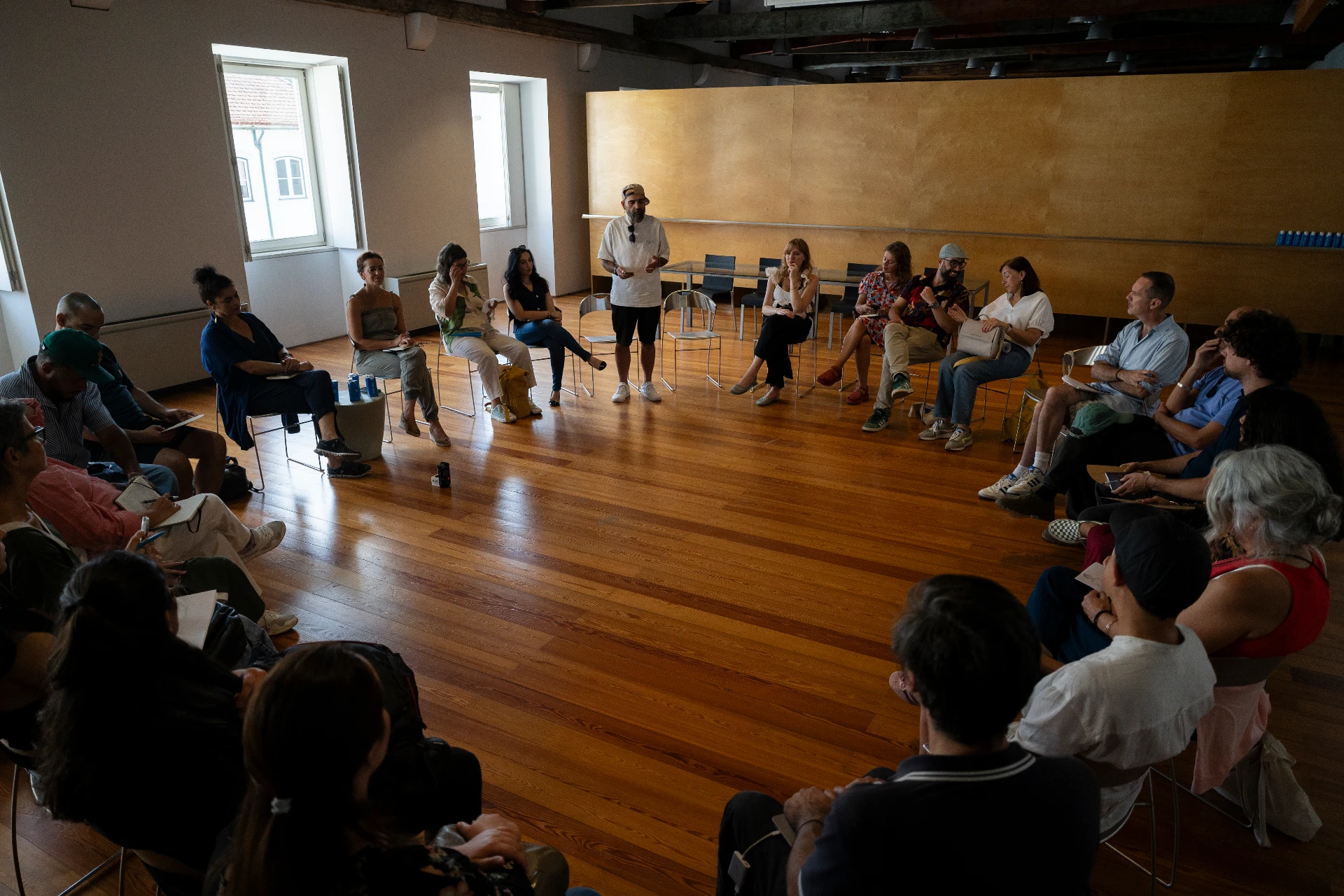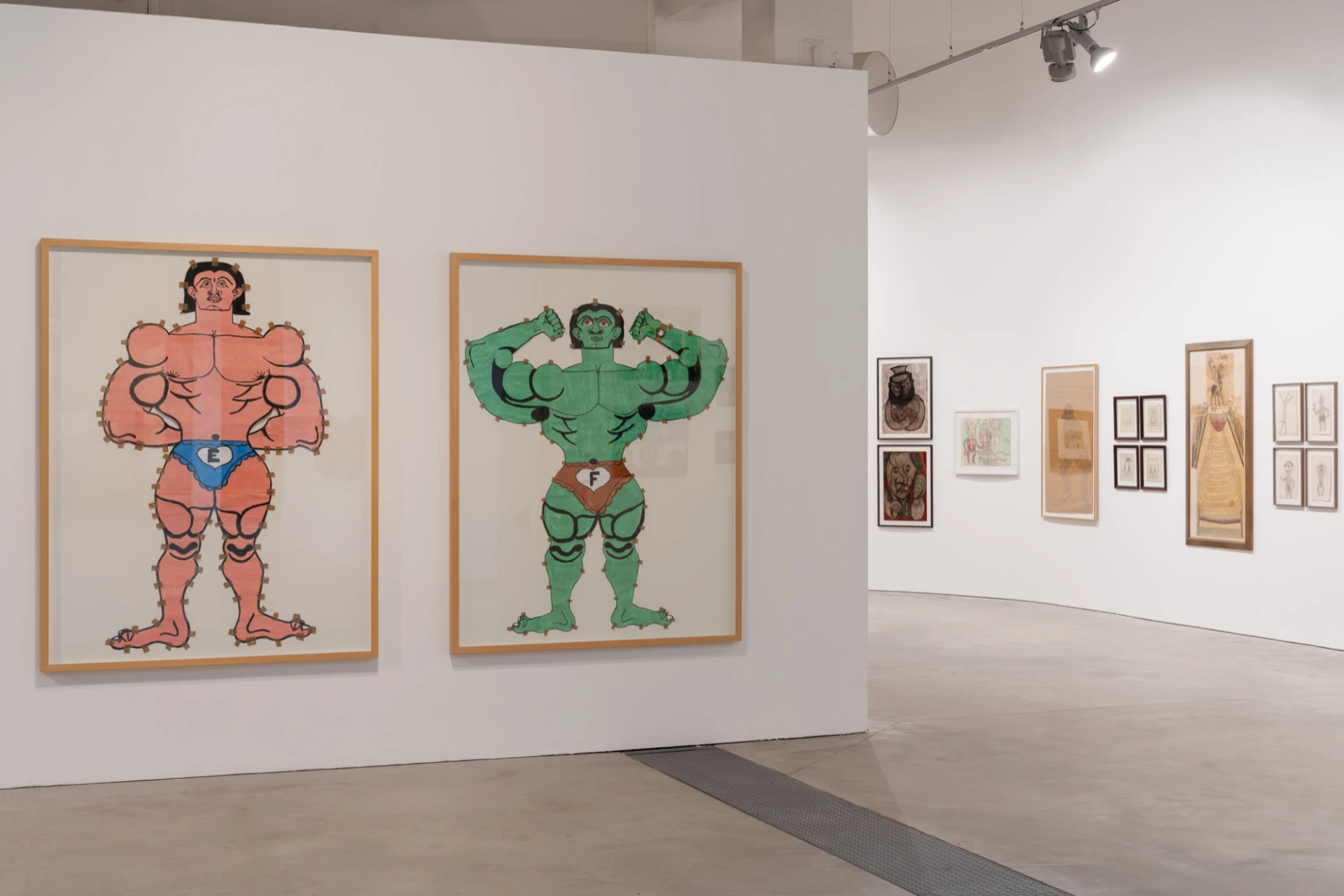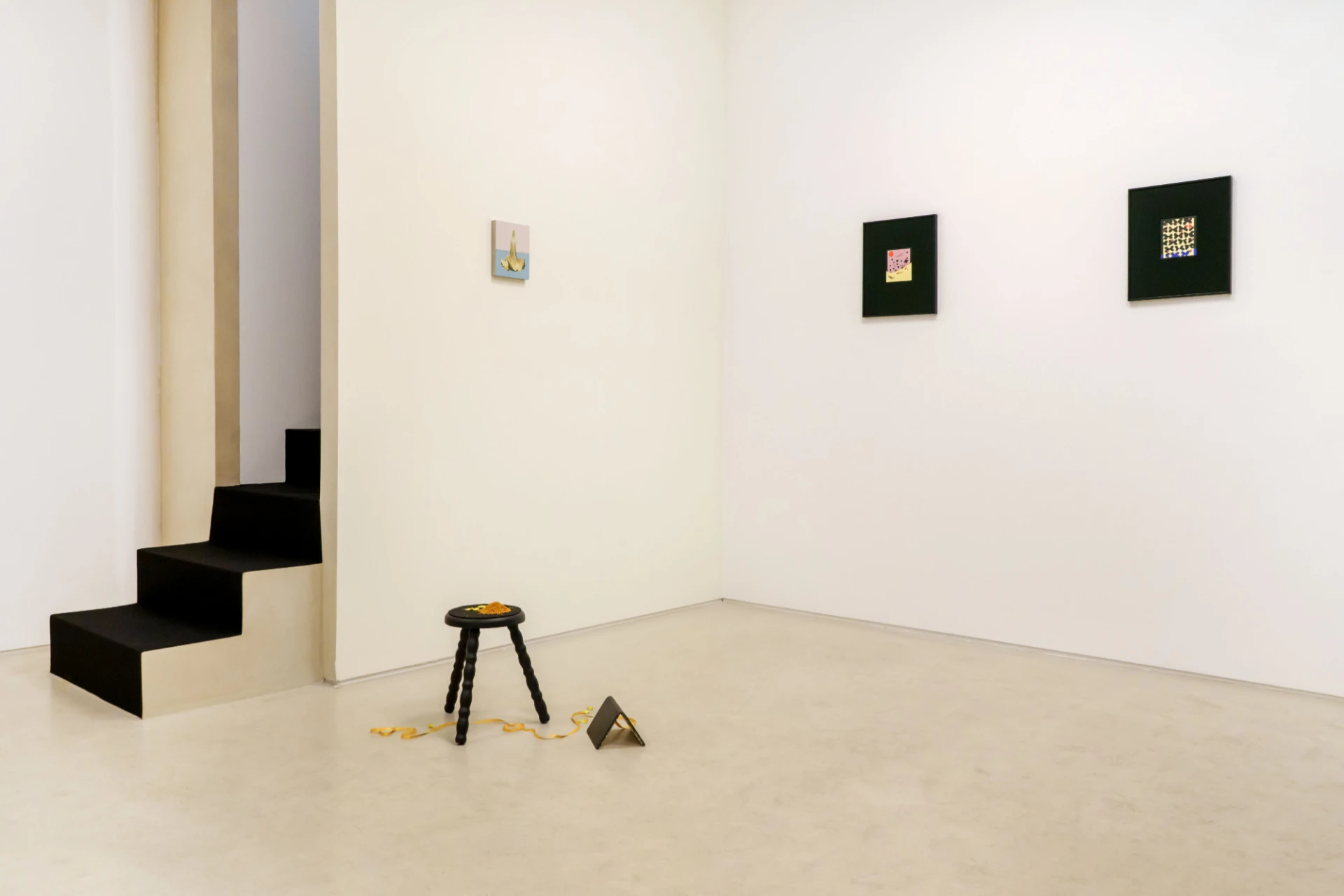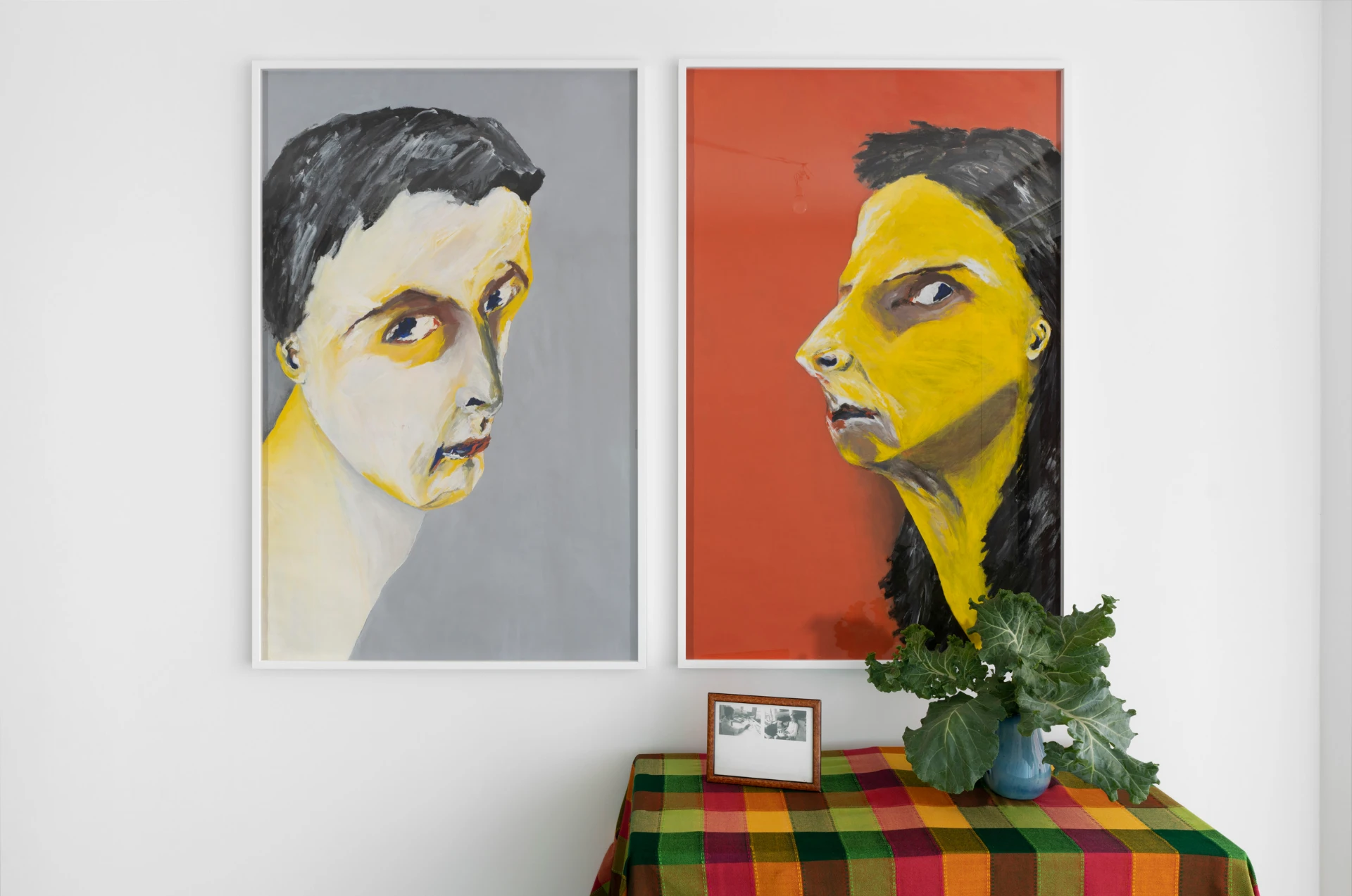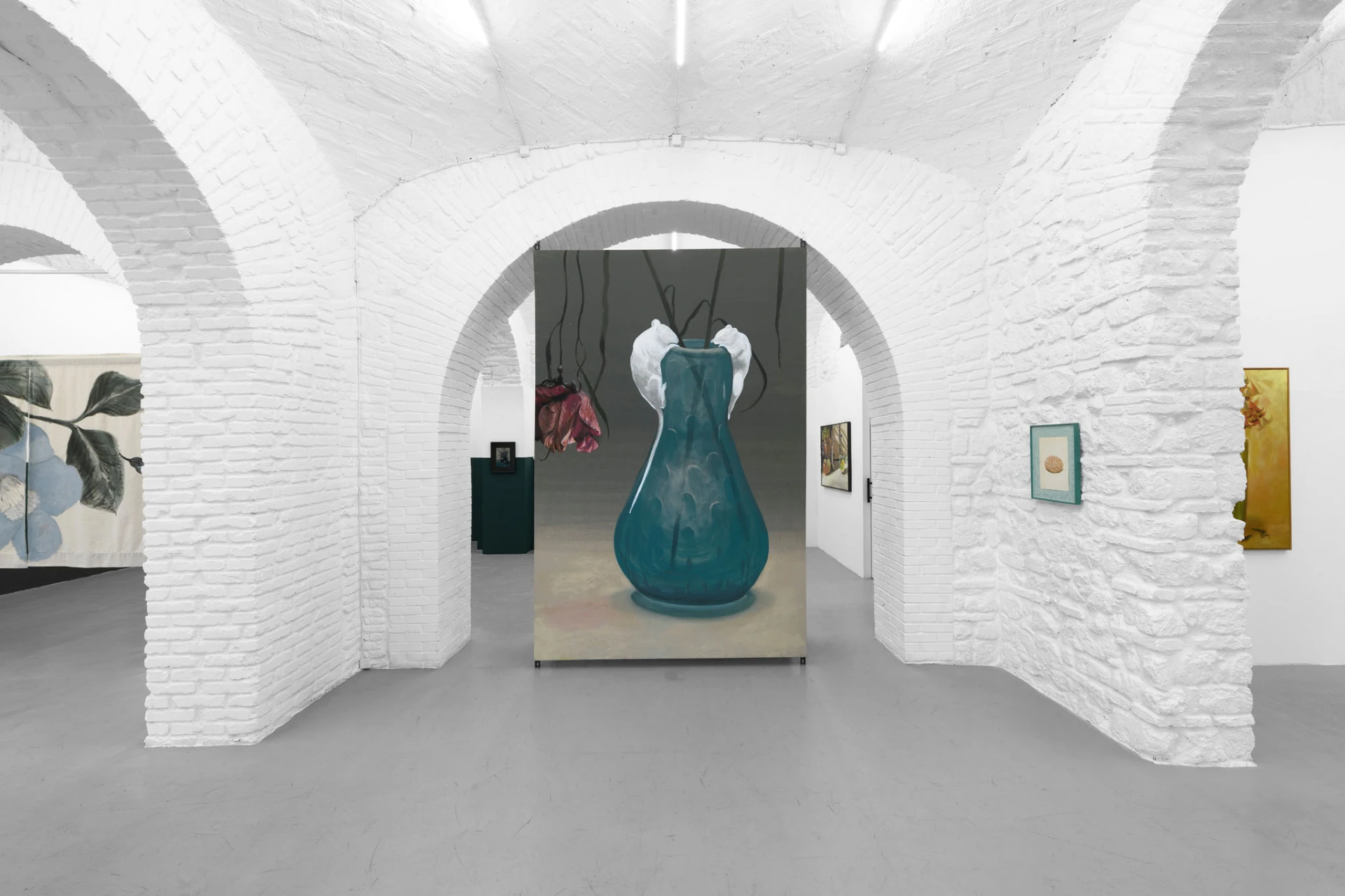Diogo E S Dietl: I suggest we organize this brief conversation into three leaps, amid significant points in your recent career. The first is immediate, moving from the group show you organized at your home, "Porta Entreaberta" (2023), to your first solo exhibition, "As primeira flores são amarelas" (2024), at Airbag. What continuities and disruptions are there in your work during this transition?
Francisca Valador: Let’s jump then! Both exhibitions played a crucial role in the development of my practice. In "Porta Entreaberta", I returned to oil painting and, for the first time, presented two paintings depicting cutouts, seeking to broaden the narrative by creating more ambiguous, less concrete images. In contrast, the titles became more evocative and descriptive. The experience of this exhibition served as a catalyst for me to venture into my first solo exhibition, and these particularities carried over into "As primeira flores são amarelas". My work is based on stories, fables, anecdotes, and relationships I create between various elements. In the absence of the multiplicity of dialogues that are present in a group exhibition, the various voices emerge from these intersections. I took ideas that had been floating around for some time, ideas I'd longed to bring to life, but the opportunity had never arisen. The starting point was the color yellow, which until then hadn't appeared often in my work and had even made me feel somewhat uncomfortable. It's not that I disliked the color; I've always found it a beautiful color—the color of the sun, pollen, lemons—but it didn't suit me. So, the idea was to explore it to better understand it. In this exhibition, new needs arose. The space was larger, with two floors, and I felt the need to create distinct environments, one more daytime and sunny, the other more nocturnal and cavernous. It was also here, after feeling this desire in "Porta Entreaberta", that my paintings emerged from their frames, onto stainless steel supports. Some elements carried over from one exhibition to the next, gaining new life—the cutouts, the socks, the flowers, the furniture—others disappeared, or rather, hibernated.
DD: Still thinking about this parallel, what challenges were involved in terms of preparations and the organizational aspect?
FV: "Porta Entreaberta" emerged at a time of transition. I was moving and had no plans to show my work in the future, which created the opportunity to transform my empty apartment into an exhibition space. In the end, I stayed in the same apartment, where I still live today, and where traces of that encounter can still be found. At that time, I was going to show solo work for the first time in several years; I didn't want to do it alone; I preferred to share the opportunity. Choosing the people to be part of the exhibition came naturally; their work had a domestic feel, with different aesthetics and approaches, but I felt it somehow connected with mine and resonated with me. Inês Brites, Sara Graça, Sara Mealha, Leylâ Gediz, and Eva Oddo—some longtime friends, others who became friends later. As Eva wrote in the text for the occasion, they "took flight together," and how beautiful it was! A challenge that ran through both projects was the budget. In "Porta Entreaberta", I knew I could draw on the enthusiasm of the artists I was inviting, but when organizing a group exhibition, it was important to me to find a way to recognize and value the time and ideas each of them brought. I secured support for the creation of the Gulbenkian, which allowed me to move forward with the project. For my first solo exhibition, I won the Flechada Prize from FLAD. I try to be economical with materials, sometimes out of necessity, but also as a form of challenge, pushing the idea to its limits. For example, in "Porta Entreaberta", there was a sock hanging from the balustrade of the building's facade. It was just a plaster-covered sock; the title told the story. Some visitors thought it had been elaborately cast in bronze, while my grandmother thought it was the sock her upstairs neighbor had dropped. I tend to complicate things, so I love this exercise of reaching a conclusion simply. But in the case of "As primeiras flores são amarelas", the support was crucial: it allowed me to put the exercise aside for a moment and gave me the time and space to try new things, to make mistakes, and to start over. Studio work can sometimes be lonely. I find great richness in sharing, and I knew this exhibition would also be a time to find new ways of communicating. I wanted to explore mediums I'd never explored before, and I ended up crossing paths with Adriana João, who interpreted the exhibition through sound, and with Di Lança Branco, who gave a new interpretation with a text-poem evoking her own memories. There's a lot of backstage work that goes into designing an exhibition, and it's not always easy when you're doing it alone, but when things start to take shape, it's a real thrill.
DD: You mentioned the stainless steel supports, which just weeks before showing in Lisbon you debuted at Artissima, Turin (IT): a hurricane oil painting in which a bird (a recurring theme in your work) crosses a sea of cutouts. At the same fair, where you participated with Matèria, you presented a set of more serene, elegantly absorbed works—a series of watercolors based on butterfly wings. Days later, you were also part of "The Kitchen Show" (curated by Felix Vong and myself, at Estúdio Atilho), with site-specific sculpture works. These are very distinct approaches, one more planned and firm, the other open and improvisational. Are they places of comfort for the development of your practice, or were they ways of responding to concrete proposals?
FV: These are very different contexts and the answers were adjusted. It's not common to think of works as a series, although it's quite common to see repeating elements that transition from one to the next, ultimately creating a certain cohesion. The works you mention and which I presented at Artissima are among the rare cases in which the paintings were conceived sequentially, as a form of support. The fair can be a violent place; it's a huge explosion of information, with so much to see and process. Thus, within a small family, the paintings found a sense of serenity among themselves. "The Kitchen Show" was a project created by artists, by people who enjoy thinking about art, and by friendships. These types of projects arise from the attempt to meet needs, but they shake things up in very interesting ways. If I may share, you and Felix met at my house, at "Porta Entreaberta", and from there emerged an exchange of ideas, a desire to bring people together, and, consequently, the "Kitchen Show". These moments are precisely what privileges this. As the name suggests, the exhibition was taking place in a kitchen space. The context itself called for more experimental play; it didn't make sense to show something you already had. It was an opportunity to look around and enjoy what the space had to offer.
DD: "As primeiras flores são amarelas" had something of a story—the settings, the characters, the narrative suggestions. As your introductory text revealed, everything began to blossom from childhood memories, of a bee living in your father's skin, who also passed on the knowledge contained in the title. However, I feel that experiencing your exhibition without such support would have left us feeling the same way in this enchanting atmosphere, trying to unravel a magical story from the richness of details, dialogues, surprises, and characters—the half-snake and the mouse, the Noturnas, the sunflowers, the scarecrow's features, the five-leaf clovers, etc. You mentioned how the exhibition's "voices" emerge from the intersection of works, but did you also consider this celestial scope, this micro-mythology, or do your reflections unfold from work to work, and in the end, you allow yourself to be as surprised as we are by the encounter?
FV: My work's starting point isn't usually guided by a theme, but by the objects I collect and that inhabit my paintings. This repetition, which you've also noticed, interests me; it's a form of resistance to the thirst for novelty and the immediacy demanded of us. Two apple stems, in one place they might be a tree, in the other two lovers lying in the sun. They're the same dry stems, and despite being familiar, they attempt to maintain their autonomy. With the exhibition "As primeiras flores são amarelas" it was a little different; the title already hinted at a path. I started with some well-defined ideas, and others emerged through this play of imagination. Some challenges and mistakes also led the work to other directions. Contrary to permanence and repetition, I also work with many ephemeral elements, which last only a few days or exist at specific times of the year. Right now, for example, I'm waiting for the first rains to return, and with them the clovers—it requires attention and patience. I began producing for the exhibition in mid-April, and the starting point was the flowers that appear at the beginning of the year (before the arrival of spring). When I went to collect them, they were either gone or about to disappear. To preserve their image, their existence, I began printing the remaining leaves and flowers. I wanted to continue working with cutouts, so I knew these silhouettes would take me somewhere, and that's how the first paintings in the exhibition began to emerge. It was the first step toward the rest unfolding. I wanted to transform the space, and this required planning and commitment, but it wasn't until the installation that the exhibition took on its final form. There were many pieces, even if some were discreet, and I was fortunate to have time to consider the final adjustments and dialogues in the space where the exhibition would live, at Arbag. At that moment, the narratives within each work expanded into a collective one.
DD: Let's now jump from Lisbon to Rome. Precisely five months after the inauguration of … flores … you open the doors to "A partir daqui só há dragões", at Matèria, an exhibition with a different focus on painting. Especially after that first exhibition at Artíssima and two strong presentations in Lisbon, all the pictorial work in Rome was presented on stainless steel supports. Small worlds, sometimes extremely delicate, well-defined and with plenty of room to breathe, which nevertheless expand naturally into one another—without contaminating or consuming each other, in a harmony of meditations, consolations, and promising bonanzas that seems to improve with each new work. What was it like building this universe, especially for a remote exhibition space?
FV: I had just opened my first solo exhibition when the opportunity arose for this second. "There are dragons here," in Latin, "Hic sunt dracones," refers to a note left on medieval maps to identify dangerous or unknown areas. I stumbled across these notes, lost in a notebook I'd forgotten, and, not quite knowing what would come next, they fit perfectly. "A partir daqui só há dragões", and I was hoping to find one! As you point out, the exhibition would no longer be next door, which posed new challenges. This time, I wouldn't have the opportunity to consider the works in the location where they would be installed, and I would have to make decisions more in advance. It was now winter, and my biggest challenges were the cold and humidity, which increased the drying time of the paintings. Since I would be transporting everything to Rome, I would have to be perceptive. I was exploring these new supports, stainless steel, shiny, polished, and heavy, and I wanted to give greater emphasis to the painting. To see how it survived, on its small scale, in a large space. Thus, an "invisible" exhibition emerged—peeking from afar, one would only see dots, a constellation. It would be necessary to slow down and pay close attention to unravel the small universes of each painting. The space would breathe, and so would the paintings. In three suitcases, I ended up taking everything with me on the plane.
DD: The exhibition included several sculptural compositions: on the floor, a pair of gloves supporting a nest, and, suspended from the wall, a spoon containing three bronze star anise flowers, along with several other elements that were more likely to go unnoticed. Clearly from the same source and fully aligned in the exploration of a territory, your sculpture has a somewhat different nature from painting. What role does each medium play in your practice, and how do you approach them?
FV: Paintings require a lot of time and attention, several hours in the same position, and concentration isn't always there. Sculpture appears as a break, something more physical that allows the body to move in different ways—kneading, cutting, sanding, mixing. And, in fact, the transition to three-dimensionality is very similar to the objects I collect, almost like amulets, and ends up helping me think about painting. Discreet, the sculptures you mentioned help give rhythm to the exhibition, create multiple levels, and have a domestic meaning that is sometimes more tangible than painting. Robert Walser has a small book of short stories, quite simple, featuring everyday objects. Each of these stories is like a small painting, conjuring up many images. One of them tells the story of gloves forgotten on a table. Several people pass by, trying to guess who those gloves might fit. When I imagined the play Nest with the blue gloves, I didn't have this story in mind; I only remembered it later. But it's a bit like that, as if each of these objects adds an external character, raising the question—who passed by there? Or like Hansel and Gretel, who leave little crumbs behind so they don't get lost.
DD: In Rome, you also continued the work with shadow and light that you demonstrated in Arbag, an exploratory and experimental gesture that you extend and in some ways invert. Initially, you expanded the fable into a starry night, and in "A partir daqui só há dragões" you founded an astronomical temple for the study of signs. In both, the light is neither neutral nor distant; on the contrary, it is involved, sensing, and reacting. How do you arrive at these spaces, and where do you take us?
FV: As we mentioned, in Lisbon, I knew it made sense for the lower floor to be nocturnal. The room was darkened, enveloped in a set of carpet panels with cutouts reminiscent of a Hokusai print, allowing light to filter through these small gaps. It truly resembled a starry sky. But because there were other works, the lighting couldn't be absent, but specific. So I created a set of flower-shaped lamps, "Inflorescência"—when a flower is composed of several smaller flowers, a sort of cluster, is the name given. And just like a flower, over time and with the heat, some of the petals would fall and occupy a new place on the exhibition floor. In Rome, I wanted to convey the idea of the cutouts that let light pass through, but because the space was different, it didn't make sense to replicate the same form. The negative became positive; what were once voids were now three-dimensional objects. Several layers of carpet, on a stainless steel support, suspended by blueberries, blackberries, snails, etc., which were actually bronze screws. They had a room all to themselves, sheltered from the light and away from the paintings. During the construction process, I called them "shadows," despite being white, silhouettes that went unnoticed. Again, I didn't want my "shadows" to be in complete darkness. Instead of transforming the lamps, I wanted to create them from scratch. In some parts of Italy, there's a long tradition of glasswork, so this transition made sense. Together with a craftsman, we blew five lamps, which, once installed, hung almost to the floor. Drops of glass on the surface—melted, condensed, or transpired—created new shadows and movements. When you called this room a "temple," I was reminded of old churches or chapels with faded and peeling frescoes, yet where something still vibrates.
DD: Let's take a transcendent leap, into the air and into the sea. The bird, or a family of birds, dove and flew in Turin, Lisbon, and Rome, amidst silhouettes, shadows, and light. Which bird would you like to be?
FV: I can't give a definitive answer, but travel is important, so it would have to be a migratory bird. Today it could be a swallow! They're elegant, and with their low flights, they always announced spring to me. Every year they returned to the doorframe of my grandparents' house, enchanting me with their sculpting skills. Piece by piece, with earth and saliva, they built their nests—small, inverted igloos, enclosed in themselves, offering total protection, preserving comfort and privacy. It seems like a good way to live, but tomorrow it could be an owl or a hummingbird!
